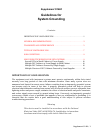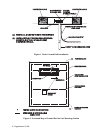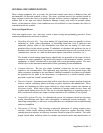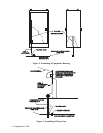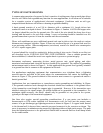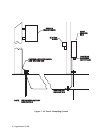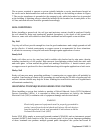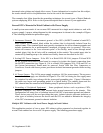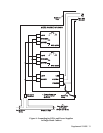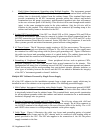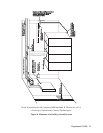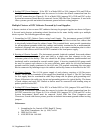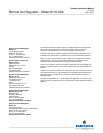Supplement S1400 / 9
The ac power required to operate a system typically includes a service transformer located at
the street and a main breaker box and rate meter assembly at the building as shown in Figure
7. The service transformer is grounded at the company's pole, while the breaker box is grounded
at the building. A lightning arrestor should be included at the breaker box in each phase of the
AC line, and each arrestor should be grounded accordingly.
SOIL CONDITIONS
Before installing a ground rod, the soil type and moisture content should be analyzed. Ideally,
the soil should be moist and moderately packed throughout to the depth of the ground rod.
However, some soils will exhibit less than ideal conditions and will require extra attention.
Dry Soil
Very dry soil will not provide enough free ions for good conductance and a single ground rod will
not be effective. A buried counterpoise or copper screen is recommended for these situations.
It will also be necessary to keep the soil moist through regular applications of water.
Sandy Soil
Sandy soil, either wet or dry, may have had its soluble salts leached out by rain water, thereby
reducing conductivity of the ground. High currents from lightning strikes could also melt sand
and cause glass to form around the ground rod, making it ineffective. A buried counter- poise
or copper screen is preferred for these installations along with regular applications of salt water.
Rocky Soil
Rocky soil can pose many grounding problems. A counterpoise or copper plate will probably be
required. Constructing a trench at the grounding site and mixing the fill with a hygroscopic salt
such as calcium chloride may help for a time. Soaking the trench with water on a regular basis
will maintain conductivity.
GROUNDING TECHNIQUES FOR SERIES 33XX SYSTEMS
When installing a system that includes a number of Bristol Babcock, Series 33XX Distributed
Process Controllers (DPCs), it is essential to follow the procedures set forth by the National
Electrical Code (NEC) to minimize risk of equipment damage and electrical shock.
WARNING
Electrically powered equipment must be properly grounded to
protect users from electrical shock and injury. All such devices
must be installed, wired, and grounded in accordance with the
National Electrical Code (NEC).
Series 33XX DPCs employ a power grid ground terminal (CHASSIS) and an instrument ground
terminal (24VRET) that connects to the "zero reference point" of the system. Improper grounding
of these terminals can produce multiple ground paths throughout the system and result in



